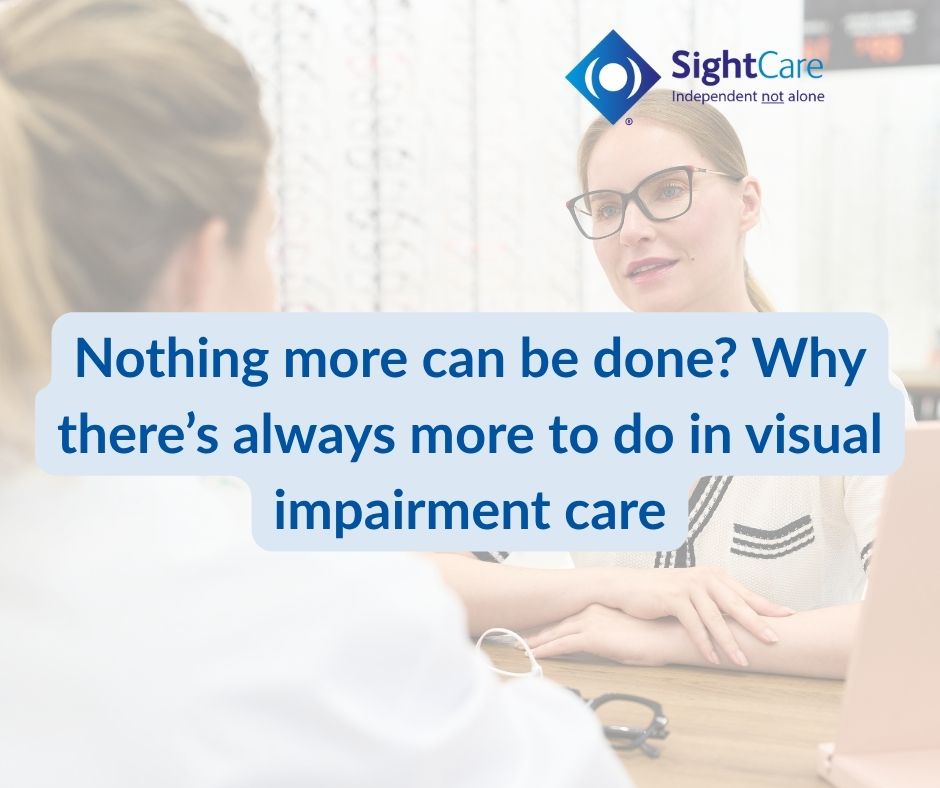Nothing more can be done? Why there’s always more to do in visual impairment care
By Daniel Morgan-Williams, Founding Director of Visualise Training and Consultancy
One of the most damaging sentences a patient with sight loss can hear is: “There’s nothing more we can do.” It closes the door on hope, shuts down conversation, and leaves people feeling abandoned at the very moment they need empathy and support. The reality is there is always more that can be done — medically, socially, practically, and emotionally. This article explores the emotional impact of visual impairment, why empathy matters, and how optometrists and opticians can support patients far beyond the consulting room.
Empathy and Emotional Intelligence
You may sit there and think, “I’m not a psychiatrist or a psychologist, my role is the eyes.” But everything you say in that consulting room leaves an imprint. When you deliver a diagnosis or even hint at a suspected diagnosis, the patient sitting opposite you is not just processing clinical information — they are experiencing fear, grief, and uncertainty about their future. Many will leave your room terrified, feeling like their life has just been split into ‘before’ and ‘after.’
You might then refer them to an ophthalmologist. But in many cases, that referral could mean months of waiting. And during those months, while the paperwork moves slowly through the system, the patient’s mental health may be a ticking time bomb. This is why showing empathy and using emotional intelligence is so important. The way you speak, the time you take, and the reassurance you give can make the difference between despair and resilience.
Maslow’s Hierarchy of Needs and Sight Loss
Visual impairment doesn’t just affect eyesight; it disrupts every level of human need. At the physiological level, people struggle with reading labels, taking medication safely, or cooking meals. At the safety level, they may lose confidence crossing the road or navigating public transport. Belonging becomes harder when social activities feel inaccessible. Esteem takes a hit when work opportunities shrink or independence is lost. And self-actualisation — the pursuit of hobbies, passions, and dreams — can suddenly feel out of reach.
Optometrists and opticians play a vital role in helping patients rebuild this hierarchy. A magnifier may restore independence in cooking, a referral to a local charity can rebuild a sense of belonging, and thoughtful communication can preserve self-esteem. This isn’t about solving everything — it’s about recognising that every action you take either helps a patient climb back up the pyramid or pushes them further down.
Case Studies
Mrs Patel – Regaining confidence
Mrs Patel, aged 67, was diagnosed with macular degeneration. She loved cooking for her family, but gradually stopped because she could no longer read food labels or recipes. At her appointment, instead of being told “there’s nothing more we can do,” her optician demonstrated improved task lighting, provided information on handheld magnifiers, and referred her to a local sight-loss charity. Within weeks, Mrs Patel felt she had regained control of her kitchen — and her sense of self.
John – Just a pair of eyes
John, aged 45, lives with retinitis pigmentosa. At his diagnosis, he was told bluntly that nothing more could be done. He left the consultation feeling invisible, reduced to just a pair of failing eyes. Over time, he withdrew from his job and social life, developing severe anxiety. John’s story illustrates the harm caused when professionals don’t look beyond the clinical picture. A referral to a rehab officer or support group could have changed his trajectory.
Sarah – Climbing back up the pyramid
Sarah, a 32-year-old professional with diabetic retinopathy, struggled first with reading medication labels, then with commuting safely, and eventually with social withdrawal. Her optometrist, however, introduced her to smartphone accessibility features, showed her a video magnifier, and signposted her to peer support. Slowly, Sarah rebuilt her confidence and was able to continue working. Her story shows how small actions can help patients climb back up Maslow’s hierarchy of needs.
Practical communication tools
In the UK, we are used to asking “How are you?” and hearing the automatic reply: “I’m fine, thanks.” But patients who have just been told they have an eye condition may not be fine at all. That polite mask often hides fear, sadness, and uncertainty. This is why emotional intelligence matters — instead of taking “I’m fine” at face value, try a gentle follow-up: “Are you sure? It’s okay if you’re not fine — many people feel shaken when they first hear this news.” A small acknowledgement like this can open the door to honesty and help patients feel less alone.
Empathy isn’t abstract — it can be put into practice with simple questions and thoughtful language. Here are some ideas you can use during consultations:
Helpful questions to ask:
- “What’s your biggest concern right now?”
- “How is this affecting your daily life?”
- “What would make things easier for you while we wait for your ophthalmology appointment?”
- “Would you like me to connect you with local charities or support groups?”
Ideas for reassuring language:
- Instead of: “There’s nothing more we can do.”
Try: “There’s a lot we can do to support you while we wait for your hospital appointment.”
- Instead of: “This is just how it is now.”
Try: “This may feel overwhelming, but there are tools, services, and support that can make life easier.”
Optometrists and opticians hold enormous influence over how patients experience visual impairment. Every consultation is an opportunity to provide not just clinical care, but hope, dignity, and direction. Never underestimate the power of empathy and emotional intelligence. And above all, never say “there’s nothing more we can do.” There is always more — if not medically, then socially, practically, and emotionally.
To learn more, visit https://visualisetrainingandconsultancy.com or email info@visualisetrainingandconsultancy.co.uk

